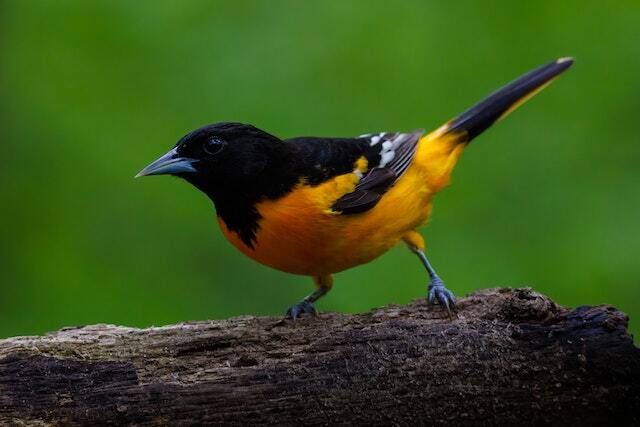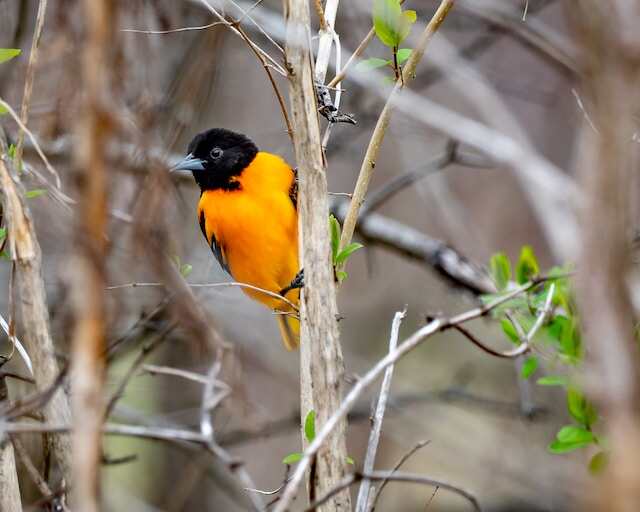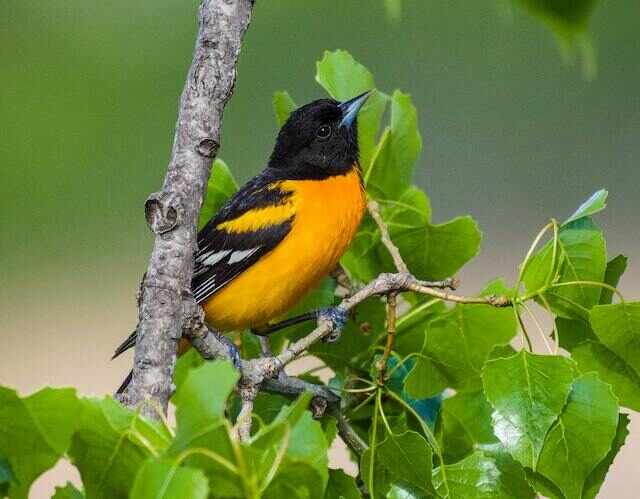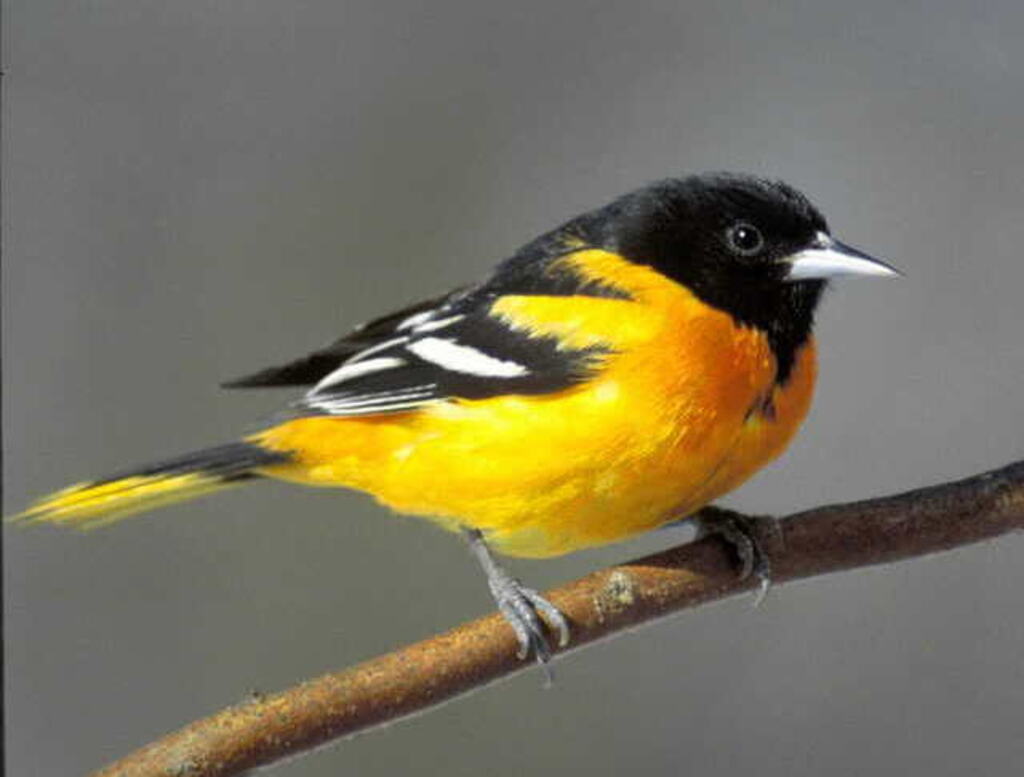Get ready for a fruity mystery with Baltimore Orioles! These captivating birds boast vibrant orange plumage and melodious songs. But the burning question is: “Do Baltimore Orioles Eat Raisins?”
Discover their diverse diet of insects, fruits, and nectar, and uncover if raisins make the cut.
Let’s explore these fascinating feeding habits of Baltimore Orioles, shedding light on their natural food sources and opportunistic eating behaviors.
Table of Contents
- 1 Overview of Baltimore Orioles’ Feeding Habits
- 2 Do Baltimore Orioles Eat Raisins?
- 3 Natural Food Sources
- 4 Opportunistic Feeding Behaviors
- 5 Other Foods That Baltimore Orioles May Eat
- 6 Attracting Baltimore Orioles to Your Feeder
- 7 The Benefits of Feeding Baltimore Orioles
- 8 Are Raisins a Suitable Food Choice for Baltimore Orioles?
- 9 Conclusion and Final Thoughts
- 10 Frequently Asked Questions
- 11 Author
Overview of Baltimore Orioles’ Feeding Habits
The feeding habits of Baltimore Orioles are diverse and can have implications for their overall health and survival. These birds have a preference for nectar, insects, and fruit, and they play an essential role in pollination and seed dispersal.
Baltimore Orioles are migratory birds, meaning they travel from one place to another to find food and breeding sites.
During migration, they rely on natural food sources such as fruits, berries, and insects, which are abundant in their breeding and wintering grounds.
Their feeding preferences may also vary depending on the time of year and availability of food. Understanding the feeding habits of Baltimore orioles is crucial for their conservation and management.
In the subsequent section about natural food sources, we will explore in more detail the types of foods that Baltimore Orioles consume and how they obtain them.

Do Baltimore Orioles Eat Raisins?
Yes, Baltimore Orioles do eat raisins. Raisins can be offered as a supplemental food source and are known to attract these colorful birds. They are drawn to the sweetness of raisins, making them a delightful addition to your bird feeding repertoire.
Natural Food Sources
This section explores the natural food sources that are available to Baltimore Orioles. These birds are known to be insectivores, but they also feed on fruits, nectar, and seeds.
Orioles are attracted to fruit trees such as cherries, blueberries, and grapes, and they also consume insects such as caterpillars, spiders, and beetles.
The benefits of foraging for natural food sources include a diverse diet that is rich in nutrients and minerals. A natural diet diversity ensures that birds receive a balanced diet that meets their nutritional needs.
Orioles rely on their natural food sources to maintain their health and vitality, and they have evolved to be able to extract nutrients from a wide range of food sources.
The next section will explore opportunistic feeding behaviors that Baltimore orioles exhibit in addition to their natural diet.
Opportunistic Feeding Behaviors
Opportunistic feeding behaviors are a common occurrence in the avian world, and Baltimore Orioles are no exception, with research showing that they opportunistically feed on insects and fruit in urban environments.
Their foraging techniques include a combination of gleaning insects from vegetation, hovering to catch insects in mid-air, and probing for insects and fruit.
Environmental factors, such as the availability of food and habitat, also play a role in their feeding behaviors.
For example, in areas with a high abundance of fruit trees, Baltimore Orioles have been observed feeding more on fruit than insects.
These opportunistic feeding behaviors allow Baltimore Orioles to adapt and thrive in urban environments, where their natural food sources may not be as abundant.
Moving on to other foods that Baltimore Orioles may eat, they have also been known to consume nectar, spiders, and even small vertebrates.

Other Foods That Baltimore Orioles May Eat
Baltimore Orioles exhibit a diverse diet that includes not only insects and fruit, but also nectar, ants, spiders, and small vertebrates.
However, they are also known to consume other foods, such as jelly and mealworms.
Alternative options to attract Baltimore orioles to your feeder include offering orange slices, sliced grapes, and even peanut butter.
These foods are high in nutritional value and can provide a variety of flavors for the birds to enjoy.
Additionally, providing fresh water sources can also attract Baltimore Orioles to your feeder.
By offering a variety of food options and a fresh water source, you can increase the chances of attracting these beautiful birds to your backyard.
Attracting Baltimore Orioles to Your Feeder
Attracting Baltimore Orioles to your feeder requires careful consideration of the feeder type, food variety, and water supply.
Choosing the right feeder is essential, as Baltimore Orioles prefer open tray or hopper feeders that offer a clear view of their surroundings.
Offering a variety of foods, such as nectar, fruit, and insects, will appeal to their diverse dietary needs, while providing a water source will ensure they stay hydrated and healthy.
Choosing the Right Feeder
Selecting the appropriate feeder can greatly enhance the likelihood of attracting desirable avian species, ultimately contributing to a more diverse and vibrant backyard ecosystem.
When choosing a feeder, it is important to consider the different types available, including tube, hopper, platform, and suet feeders.
Each type of feeder has its own advantages and disadvantages, and the choice ultimately depends on the types of birds you want to attract and the environment in which the feeder will be placed.
For example, tube feeders are ideal for small birds like finches, while hopper feeders are better suited for larger birds like jays and woodpeckers.
Feeder placement is also crucial, as birds prefer feeders that are located in a safe and open area, away from predators and potential hazards.
Once you have selected the appropriate feeder and placed it in a suitable location, the next step is to offer a variety of foods to attract a diverse range of avian species.
Offering a Variety of Foods
Providing a diverse range of foods is essential in creating a thriving backyard ecosystem that supports a variety of avian species. To attract Baltimore Orioles, it is important to offer a variety of foods that cater to their specific dietary needs.
Here are three items to consider when offering a variety of foods:
1) Mixing fruits such as oranges, grapes, and berries can be an excellent source of natural sugars that Orioles crave.
2) Insects diversity such as mealworms, ants, and spiders can provide necessary protein for their diets.
3) Nectar from flowers can also be a great addition to their diet.
To ensure a healthy backyard ecosystem, it is important to provide a mix of these foods to attract a variety of birds.
Incorporating different food sources can also promote biodiversity and attract other avian species to your backyard.
In addition to providing a variety of foods, it is also important to offer a clean source of water for drinking and bathing.
Providing Water
To ensure that Baltimore Orioles are healthy and well-fed, it is important to offer them not just a variety of foods but also access to water.
Water accessibility is crucial for their survival and hydration techniques should be implemented in order to keep them healthy.
Providing water for birds can be done through different methods such as bird baths, drippers, and misters.
A bird bath is a shallow container with water in it that is placed in an area where birds can easily access it.
Drippers are designed to slowly drip water into bird baths, while misters emit a fine spray of water into the air, which birds can fly through.
The goal is to make water easily accessible to birds in order to encourage them to drink and bathe.
By providing water to Baltimore Orioles, we are not only promoting their health, but also enhancing their experience in our backyards.
This leads us to the next section about the benefits of feeding Baltimore Orioles.

The Benefits of Feeding Baltimore Orioles
This section highlights the advantages of incorporating certain foods into the diet of a particular bird species, prompting one to consider the potential benefits of feeding a bird such foods.
When it comes to Baltimore Orioles, their diet is diverse and includes fruits, insects, and nectar.
Meeting their nutritional needs is crucial for their survival and health, especially during migration, when they require high-energy foods.
Feeding Baltimore Orioles can also be a rewarding experience for bird enthusiasts, as it attracts these beautiful birds to their yards and provides an opportunity for observation and photography.
Additionally, feeding Baltimore Orioles may also contribute to conservation efforts by promoting awareness of these birds and their habitat needs.
As such, understanding the benefits of feeding Baltimore orioles can inspire individuals to provide them with appropriate foods and contribute to their conservation.
With that said, are raisins a suitable food choice for Baltimore orioles?
Are Raisins a Suitable Food Choice for Baltimore Orioles?
The suitability of incorporating raisins into the diet of Baltimore orioles warrants consideration in light of their nutritional requirements and feeding habits.
While raisins are a good source of energy due to their high sugar content, they are not a suitable food choice for Baltimore Orioles.
These birds are primarily insectivores and their diet consists mainly of insects, spiders, and other small invertebrates.
While they may occasionally feed on fruits and berries, these make up only a small portion of their diet. Additionally, raisins are dried fruits and lack the moisture content that is essential for bird digestion.
Feeding Baltimore Orioles with raisins could lead to dehydration and other health problems.
Therefore, it is important to explore alternative food options that are more suitable for their nutritional requirements and feeding habits.
Conclusion and final thoughts will be discussed in the subsequent section.

Conclusion and Final Thoughts
The investigation into the nutritional requirements and feeding habits of Baltimore orioles concludes that raisins are not a viable food option due to their primarily insectivorous diet and need for moisture in their food.
While raisins may seem like a convenient and inexpensive option for bird feeders, there are potential dangers of feeding them to orioles.
Raisins contain high amounts of sugar and can cause digestive issues in birds, leading to dehydration and even death.
On the other hand, feeding orioles their natural diet of insects and nectar provides numerous benefits, including essential nutrients and hydration.
As responsible bird enthusiasts, it is important to prioritize the health and wellbeing of these beautiful creatures by providing them with suitable and nutritious food options.
Frequently Asked Questions
How do Baltimore Orioles mate and reproduce?
Baltimore Orioles are known for their beautiful songs and vibrant plumage. These birds are monogamous and form long-lasting pair bonds.
Their nesting habits are intricate and involve the male and female working together to construct a pendulous nest made of plant fibers, grasses, and other materials.
Courtship behavior is also important in the Baltimore Oriole’s reproductive process. The male will perform a courtship display, including fluffing up his feathers, singing loudly, and bringing food to the female.
The role of hormones in Baltimore Oriole reproduction is also significant. Hormones such as testosterone and estrogen play a crucial part in their reproductive cycle, including nest-building, egg-laying, and incubation.
By understanding the behavior and biology of Baltimore Orioles, researchers may be able to develop innovative techniques for conservation efforts and habitat management.
What are the predators of Baltimore Orioles?
Baltimore Orioles are a species of bird found in North America, typically inhabiting forests and woodlands. They are known for their bright orange plumage and melodic songs.
However, despite their striking appearance, Baltimore Orioles are vulnerable to a range of predators, including birds of prey such as hawks and owls.
These predators are known to hunt Baltimore Orioles in their natural habitat, particularly during the breeding season, when the birds are more likely to be out in the open.
Nevertheless, Baltimore Orioles have evolved a number of strategies to avoid predation, such as building their nests high up in trees and remaining alert to potential threats.
Overall, while Baltimore Orioles are a beloved species among birdwatchers and nature enthusiasts, they face a range of challenges in the wild, including predation by birds of prey.
What is the lifespan of Baltimore Orioles?
Baltimore Orioles are known for their vibrant orange plumage and melodious songs, making them a popular sight among bird enthusiasts.
The diet of Baltimore Orioles consists mainly of insects, fruits, and nectar. They have a particular preference for caterpillars and spiders, which are crucial sources of protein for their young.
The fruit they consume include berries, oranges, and grapes, but information on their preference for raisins is scarce.
The lifespan of Baltimore Orioles varies depending on several factors, such as predation, disease, and habitat loss.
On average, they can live up to 8 years in the wild, but some have been known to live up to 14 years.
However, their lifespan can be significantly reduced by threats such as predation by snakes, hawks, and cats, as well as habitat destruction caused by human activities.
Therefore, conservation efforts to preserve their habitat and reduce predation are essential to ensure the long-term survival of Baltimore Orioles.
How do Baltimore Orioles migrate, and where do they go?
As the Baltimore Orioles migrate, they have a diverse diet that consists of insects, fruits, and nectar. During their migration, they stopover at favorite spots such as Mexico, Central America, and the Caribbean.
However, climate change is affecting their migration patterns, causing them to arrive at their destination earlier than usual, which can disrupt their food sources and breeding habits.
The changing climate has also led to shifts in the timing and location of flowering plants, which can impact the availability of nectar for the Orioles.
It is crucial to study and understand the effects of climate change on the Baltimore Orioles’ migration patterns to develop effective conservation strategies to protect these beautiful birds.
So while we may not know if Baltimore Orioles eat raisins, it is essential to focus on the bigger picture of their migration and the impact of environmental changes.
How do Baltimore Orioles communicate with each other?
Baltimore Orioles are known for their beautiful songs, which they use to communicate with each other. These vocalizations play an important role in the birds’ migration patterns, allowing them to navigate and find their way to their breeding and wintering grounds.
Orioles are able to produce a variety of sounds, including whistles, trills, and warbles, which they use to convey different messages to other birds.
In addition to vocalizations, these birds also use body language and other visual cues to communicate.
Studying the communication patterns of Baltimore Orioles can provide valuable insights into their behavior and ecology, and can help us better understand the complex processes involved in bird migration.



